Butter Chicken, to me, is Indian food perfected! Fall-apart tender bits of perfectly seasoned, marinated chicken swimming in a rich, deep tomato-based sauce packed with spices and laced with cream, butter and all other things that do the body good.
Butter Chicken in all her beautiful glory… In this case from one of my favorite Indian haunts, Bollyfood in Copenhagen
Oh, sure, Indian food has a lot of great curry dishes – some simple, some the polar opposite of simple, some vegetarian, some pescatarian and others again meat-based – on about every type of critter (save cows) you could think about, including mutton and a few other strange beasts.
Few Indian curries, however, are as intricate, as deeply flavorful, as wonderfully complex and aromatic and as rich and creamy in texture as Butter Chicken. Butter Chicken, when done correctly, is slow food at its very peak with all the spice, warmth, charm and character of the Indian sub-continent included.
That aside, however, can we just stop to appreciate for a while, the beauty of a dish in which butter is such a prominent ingredient that it becomes, in fact, a significant part of the dish’s name … Makes you smile, does it not? Oh yes, Butter Chicken is, indeed, Indian food perfected!
So why does Butter Chicken not get more attention in the grand scheme of iconic dishes from around the world? Probably because there’s a lot of confusion going on as to the true nature of Butter Chicken.
Butter Chicken vs Chicken Tikka Masala: What is the difference?
Now, the trouble with Butter Chicken is that it is so often and quite easily confused with another exceedingly popular “Indian” dish: Chicken Tikka Masala! Both are, after all, curries made from tender, marinated chicken pieces served in a rich tomato-based sauce. But there are both subtle and not so subtle differences between the classical Indian dish, Butter Chicken, and the British invention, Chicken Tikka Masala, the first and most obvious of which is the use of a healthy dose of butter in the original recipe, as the name suggest. The second obvious difference is that Chicken Tikka Masala, despite its name and appearance is as Indian as crumpets and tea. It was, in fact, invented by curry house chefs in Scotland.
Moreover, Butter Chicken is usually made from tandoori-chicken, i.e. chicken grilled in a fiery hot tandoor oven, whereas Chicken Tikka Masala is made with pan-fried chicken. Because one dish needs meat that cooks fast and easily on a pan while the blazing heat of a tandoor oven would dry out fast-cooking meat in a flash, another inherent difference between the two dishes is that Chicken Tikka Masala is traditionally made with white (breast) meat, while Butter Chicken is made with (dark) thigh meat which can handle not only the heat of the grill, but also the subsequent simmering in the sauce.
As far as flavor goes, Butter Chicken is often a much richer, yet mildly spiced curry, deriving its flavors from intensely cooked down tomatoes, slow-cooked chicken, butter and cream on a backdrop of garam masala and aromatics. Chicken Tikka Masala, on the other hand, is (relatively speaking) much quicker to prepare and as such, a less intricate and pungent dish, relying on spice rather than richness and depth of flavor to carry the dish.
Chicken Tikka Masala – looks a lot like Butter Chicken, does it not? So what the hell is the difference? Photo Credit: Michael Hays (Flickr) [CC BY 2.0 (https://creativecommons.org/licenses/by/2.0)], via Wikimedia Commons
One could argue, somewhat rightfully and laconically, that Chicken tikka masala is but a cheaper, quicker and dirtier version of Butter Chicken, but in all honesty that may be a bit of rough call. If anything, Chicken Tikka Masala should be considered a “light” version of Butter Chicken – and while there is nothing particularly wrong with neither that fact nor the taste of Chicken Tikka Masala, we’re just not about light versions on this site.
We’re about tradition, culinary history and perfection, and we’re all about making dishes as tasty as we can – so let’s immense ourselves in another 3000 or so words about the original Indian Butter Chicken, or Murgh Makhani as they say on the subcontinent. Let us discover together why Butter Chicken, in the eyes of many connoisseurs, rank supreme amongst Indian curries.
Butter chicken history
Unlike many other iconic dishes we’ve covered, from Chili con Carne to Pho, the birthplace and history of Butter Chicken is actually universally agreed upon by most culinary sources. Butter Chicken came to be at Moti Mahal restaurant in Delhi in or around 1950.
Whereas the place of origin of the dish is pretty simply defined, it’s history and background is a little more complicated. How, for example, did a chicken-based dish become the most iconic dish to ever emerge from Delhi, a city full of Hindus who are historically largely vegetarian.
Well, it’s a surprisingly complicated and absurdly random tale of near epic proportions. It all began, rather violently, with the division of the Indian subcontinent in 1947 when a political saw blade cut through it, effectively creating the country of Pakistan. Political unrest and secular violence in the region, caused thousands of people to flee the region and amongst these were three would-be restaurateurs, Kundan Lal Jaggi, Kundan Lal Gurjal and Thakur Dass. These brave, young men, in unison, are credited with inventing not only Butter Chicken, but also one of its key components, tandoori chicken, a few years and a couple of thousand kilometers down the road from their great escape from Pakistan.
Were it not for these men fleeing and meeting up in a strange home away from home, Butter Chicken may have never been, and in fact – if we are to belive in fate – it nearly weren’t. Sources have it, you see, that one of the co-creators, Mr Jaggi, was scheduled to be on one of the first trains out of Pakistan towards Delhi. Jaggi’s brother, however, fell ill causing him to miss his train, thus narrowly missing a tragical and completely devastating massacre on the passengers. Jaggi lived to tell the tale and traveled on to Delhi for a chance meeting with his friends to be and eventually the opening of Moti the Mahal restaurant.
Their main purpose of the restaurant was to cater to Delhi’s growing horde of meat-eating Pakistani immigrants but the place quickly became a cultural and culinary institution, owing in no small way to their invention of a prototypical Indian classic, tandoori chicken, a dish featuring skewers of marinated chunks of chicken thighs seared over blazing high heat in a tandoor oven…
Oh, and of course the small by-product there-of; a dish featuring bits of leftover tandoori chicken carefully coaxed back to life by slow simmering in a mildly spicy sauce made from tomatoes, cream and an ungodly amount of butter… In other words: Butter Chicken, a top contender for the spot of the most intense, most flavorful and most beloved Indian dish in the world… Created, mainly by chance and luck as a way to minimize food waste. Oh how beautifully the game of chance that is life works out at times.
Is it any wonder I wanted to recreate the magic of this dish at home? I think not! However, the quest proved more difficult than first expected.
The quest for perfect Butter Chicken
Coming up with the perfect Butter Chicken recipe has not been easy. It’s a dish that’s been rife with tragedy and failure for me when I’ve cooked it in the past. Possibly stemming from my complete helplessness when it comes to working with written recipes. My first and most infamous attempt with the dish involved, uh , helping my friend Malene cook it for her 30th birthday luncheon for friends and family. “Here, you can help make the sauce,” she said, and handed me a recipe card. “I can do this,” I said, “but you need to be aware that I don’t know how to follow recipes!”
I set to work, making the sauce to recipe and did what any respectable home cook would have done, tasted it and concluded that it tasted of nothing at all. “Oh well, I’ll fix this,” I thought and set out adding spices and things (and by things I mean chili peppers) until I had a fragrant and reasonably spicy tomato sauce. I was proud of myself, too, until the grilled chicken that Malene had prepared was added. I gave the dish a taste and immediately started spitting flame.
“What is this sorcery,” I quipped and turned the recipe card I’d been using to examine the marinade portion of the recipe which called for something to the tune of 5 tablespoons of Cayenne pepper to be added.Attempts to appease the Gods of Fire by addition of liberal amounts of yogurt and cream failed and while it was certainly a birthday to remember, my first memory of cooking Butter Chicken is one of damp foreheads, tears swelling, coughing and my gazing guilt-ridden at Malene’s cousin wondering “why is this pretty young girl looking at me as if I just slapped her across the face?”
Homemade Butter Chicken… Life on earth is good!
My second stab at Butter Chicken involved trying to follow and adapt Heston Blumenthal’s recipe Chicken Tikka Masala recipe which is largely based on that of Butter Chicken. It went well… Completely disregarding the fact that I missed the “makes more than needed” note on the spice blend and ended up with about a kilo of garam masala more than needed, my second attempt fared a hell of a lot better.
My only mistake, in so far as it can at all be considered a mistake, was that I chose to serve to my friends Ana, Emelie and Malene (why the latter trusted me on this one, I know not to this day), and apparently lost track of my mental notes when faced with three beautiful women and an equal number of Champagne bottles… At the end of the day, I am but a mortal man!
So, as it turns out, even when it comes to coining a recipe, third time, as they say, is the charm … Even if it sort of happens by accident… Again, I blame a female! See, I was geeking about with a number of classical (and not so classic) recipes for Butter Chicken over a bottle of Champagne (as one does), trying to combine them into one definite, perfect Butter Chicken recipe for future reference. When, if I’m perfectly honest, the idea to finally put together and publish this recipe along with a slur of explanations and notes was spawned by a comment on my Instagram:
“I can never get it just right at home, it always tastes better at the restaurant,” chirped one fellow food blogger, the beautiful and ever-inspiring vegetable butcher Christel over at christelirmow.dk… “Hey, this is what I do,” I thought, “I help people overthink basic recipes and make the best of them!”
So now, culinary gang, let’s see if we can’t help the lovely lady and ourselves out here and make some restaurant-quality Butter Chicken at home! This shouldn’t be too complicated… Right? Okay, if I’m honest, this is one of our more involved culinary adventures. But on the surface, it looks easy enough.
The Four Pillars of perfect Butter Chicken
To make perfect Butter Chicken, you need essentially four simple things! Quality ingredients, plenty of fat, time – lots of that too – and an imperial shit-ton of spices and aromatics. It’s as simple of that, really, and then again, not really. So, let’s break things down and have a look at our culinary pillars one by one.
Butter Chicken essentials: Quality of ingredients
It should come as no surprise to anybody that quality ingredients make quality food, yet a lot of home cooks cheap out when faced with the price of a happy, organic chicken, great dairy, proper spices or even quality canned tomatoes. Why? My only reasonable guess is that a lot of us suffer from a sense of dread that we will be unable to taste the difference between a DKK 25 industrial chicken and a DKK 100 farm-raised, free-range and organic chicken. Well, guess what? You can taste the difference and you should appreciate the difference!|
A few ingredients for Butter Chicken… Go quality or go home as they say!
So, for the sake of stating the obvious: your food is no better than the source of your ingredients! If you want to make the world’s best Butter Chicken, you must source and use quality ingredients. Buy some proper, organic butter and cream, get a happy, slow-raised free-range chicken and spend a few bucks on proper canned Italian or Californian tomatoes. Y’know, the ones that are actually red, flavorful and don’t taste of slave-like labor. Only through the use of proper, quality ingredients will your Butter Chicken really shine and if you’re not ready to make that investment, you may as well stop reading. Got it? Cool!
Butter Chicken Essentials: Fat is Key – Plenty of Fat
Now, this may not be good news to the health conscious in the crowd, but there is one simple primary reason why restaurant style Butter Chicken and other dishes taste much richer and creamier than their home-cooked counterparts: restaurants use more butter, cream and other types of fat than home kitchens because fat equals flavor! Butter chicken, as the name may suggest, is no dietary dish. Even so, I’ve seen “Lean Butter Chicken”, “Guilt-free Butter Chicken”, “Low-fat Butter Chicken” and all other types of culinary nonsense.
Listen, the Indian kitchen is traditionally swimming in oil, butter and ghee – for several good reasons! Other than providing a source of sustenance in a generally poor and vegetarian kitchen, fat equals flavor and, particularly in the case of cream, butter or ghee it equals creaminess, richness and a silky mouthfeel as well.
Mmmm… Butter… Where would my chicken be without you?! Lesson of the day, kids, never skimp on fat when cooking!
I’m sorry to say… No, scratch that. I’m not sorry to say that if we’re going to make great Butter Chicken, we’re going to have to throw a bit of our usual health consciousness (ahem!) plus a few home cooking conventions out the window and go big on fat. Trust me, this is one dish where you won’t want to hold back on neither oil nor butter, if you’re not down with that, again, turn away now. As for the rest of you, let’s go for a hedonistic swim in butter and oil!
Butter Chicken Essentials: Time is of the greatest necessity
There is no denying it. Great home cooking is going to eat its way into one of our most sparse commodities: time! Granted, time is something most of us strive to save when working the kitchen, and that’s all fine and dandy for quick every-day meals, but not for a classic slow-food dish like Butter Chicken which really needs time and attention to detail to shine. Even so, during my research for this dish, I came across a lot of “20 minute Butter Chicken recipes” and “fast, easy Butter Chicken recipes”… And I’m sorry, but no, just… no!
The perhaps most important ingredient for a Perfect Butter Chicken recipe is time!
- Time to toast and grind our fragrant spices from scratch.
- Time to craft a perfect marinade and let it do its thing.
- Time to slowly sweat the aromatics to bring out their flavors.
- Time to cook the tomato sauce down to a thick, rich mess.
- Time to properly grill the chicken and, most importantly:
- Time to let everything stew as to make all the flavors blend together.
For things to turn out just right, we’re talking hours upon hours, upon hours here, not downwards of twenty minutes. To cook perfect Butter Chicken we must allow time in our busy schedules over the course of at least a day, maybe two. Not active cooking time all of it, mind you, there will be a lot of in-between time involved during which you could do other important things like, say, laundry or drink beer. You will, however, to some extent, need to plan out your time well for this buttery project. Start out early, and you may get everything done in a day, but I would allow a full weekend for this project.
Don’t panic if this recipe looks a bit lengthy. It’s not all active cooking time, not at all… We’ll have plenty of time for other important projects!
Time, after all, is of the essence and our project should be fun, not stressful. You have been warned. Ready to make that investment? Great, let’s spice things up!
Butter Chicken Essentials: Tons of spices and aromatics
I will venture a guess that one reason why many home-cooked versions of Butter Chicken or other Indian dishes may seem a little bland is because, frankly, we westerners don’t know how to spice things up like an Indian grandma! It’s not that we dislike spicy and exotic flavors, those days are, thankfully over, it’s just that we have a hard time fathoming just how many different spices are needed and the sheer volume in which they are needed.
The spices and aromatics of Butter Chicken and other such dishes are not entirely familiar to most of us and our conservative nature has us holding back in fear of overdoing things: We grab a few cloves of garlic, an inch of ginger and a few shakes of pre-ground spices with a this-will-do attitude… And, no, this won’t do! Our Indian food needs to be more fire, heat and attitude than my friend and Pakistani-born internet sensation Amber Kahn on a July afternoon! Or Johnny Depp in, pretty much anything Johnny Depp does… Whichever appeals to you more should be your curry!
And we’ll achieve this goal by stocking up on plenty of chilies, garlic and ginger and a whole array of whole spices from which we will drive their very soul and essence! No… Come… Take my hand, trust me on this one!
I’ll be the first to admit that this recipe uses what to some may be considered a crazy amount of garlic, chilies and ginger. Very official and precise measurement right there, I know, but trust me (or look at the recipe) we’re going to need a lot. We will use these more pungent aromatics, however, in ways that subdue their hot, sharp pungent punches and turn them into nice, deep, aromatic undertones of the dish.
The same could be said for the spices we will employ: There are certainly a lot of them, and to the western culinary eye, they may seem a little strange and all too plentiful in all their earthy and musky beauty. Cinnamon, cardamom pods, fenugreek and Coriander seeds are but a few of the unfamiliar and strange sights and smells we will employ in this recipe to make up a unique Indian base spice blend known as garam masala which lends many Indian curries – Butter Chicken included – their unique base flavors.
And while in their own, unique and whole state, they may look a little intimidating, they are, essentially, the fragrant backdrop on which our rich and creamy curry rests. Through making our own garam masala as a part of this recipe, we will hopefully gain a better understanding of these exotic spices and their proper usage. So, have faith and be generous with the content of the spice rack even if the whole process and combinations seem a bit weird. There is a reason why this unique blend of spices has been popular for hundreds of years!
Crafting perfect Butter Chicken: Step by step
Now, knowing that Butter Chicken is essentially as simple as this, how do we turn this knowledge into the best damn chicken dish of the subcontinent? Well, first things first, we’re going to need some bits of chicken, but not just any bits of chicken!
There comes a time in any man’s life, see, where you have to ask yourself the question: Which do you like better? Breasts or thighs? Me? For the purpose of this post, I’m a thigh-loving man! With this recipe, we’re going to subject our poor chicken to a fair amount of initial heat from the grill followed by a prolonged cooking process: the tougher, fattier thigh meat simply stand up better to this sort of treatment where the leaner breast meat would simply dry out. Since we’ll be applying a marinade to our chickeny thighs, boneless, skinless chicken thigh pieces work great for this application but whole thigh pieces work well, too, if the easier option isn’t available. Simply skin them and continue as you would with the boneless, skinless variety!
Step 1: Making your own spice blend
Now, I don’t want to discourage you from the get-go, but if we’re going to make perfect Butter Chicken, we’re going to have to start out by making our own garam masala spice mix. For the first timers out there that means getting a hold of a number of whole, dried spices, a pestel and mortar or even a cheap spice grinder or coffee mill used specifically for this purpose. While the task may seem daunting and the initial investment a bit steep, don’t worry it’s all going to be a lot easier than you think and the results well worth your time and money.
Spices… Buy them whole and grind your own… Please!
Still, you may be wondering, “if premade garam masala is being sold at the store, some of it in very fancy and expensive packaging, why bother making your own?” The simple, two-fold answer here is flavor: Not only does homemade garam masala taste fresher, better and more pungent as we’ll use whole spices freshly roasted and ground to order, it’s also fully customizable. You can tweak it any damn way you like! Put it this way: If you’re not perfectly happy with the stuff at the store, you’re stuck either accepting status quo or spending a lot of money buying different mixes till you find one that suits you. If you, God forbid, don’t like my version, you can tone down or leave out the flavors you dislike and boost the ones you love, and add new flavors of their own. If you really like clove in an “I like clove, I can make this shit taste like Christmas, yo!”-way… Well, it’s your fucking choice! You can do that shit, more power to you!
By making you buy whole spices and giving you a stepping stone, I have empowered you to do so! And I encourage you to do so! Experiment with flavors, tune it up, tune it down, make this dish your own! But for the love of God, make your own garam masala and put it to good use!
Step 2: Crafting the perfect marinade
Speaking of putting to use, first and foremost, we will use our garam masala, along with chilies and copious amounts of garlic and ginger to create a marinade. A marinade based on an ingredient that may seem a little strange and unusual to westerners yet make perfect sense for our task at hand: yogurt!
Why? Well, for starters, the yogurt will help an extra bit of creaminess to the dish, but other than that, the obvious answer to anyone who has been reading our previous articles would be: For the sake of flavor!
And this is basically almost entirely correct…
The single, most important job of a marinade *is* to add flavor. Period. Oh, I know. Allow me to repeat myself, again: A lot of people, even the educated, will tell you that another purpose of a marinade is to tenderize. Now, if you want to know how to prove these people wrong and haven’t yet, you should read our previous post in which we busted this popular culinary myth and learned that marinades do not generally tenderize. In fact, the opposite can be true. While an acidic marinade does seem to tenderize meats by changing the patterns of the fibers within the meat – the effect is temporary however, as – with time – the acidity in the marinade will cause the fibers to tighten and indeed become tougher than the starting point, rather than tender.
And this is all very true, of course … Except, that is, when using marinades based on one key acidic ingredient: lactic acid found in, say, yogurt or buttermilk. Lactic acid, as it turns out, works a little different than other acidic marinade ingredients.
The strange chemistry of a yogurt-based marinade
Yogurt, unlike most other acidic marinade ingredients like vinegar, citrus juice or wine are based on lactic acid components. Simplefied speaking, these acidic components are milder than those found in, say vinegar.
Using yogurt, we’ll get many of the molecular-changing properties of an acidic marinade, only they will happen slower over time, without the risk of toughening up the meat after extended periods in the marinade. As such, overnight marination in youghurt-based marinades is not only possible, it’s generally encouraged.
With yogurt time matters, you see, as little as 15 minutes will make a difference, but going overnight or even 24 hours will give the flavors in the marinade time to really mingle, develop and cling to the meat. They will not saturate the meat – that’s another culinary myth smashed in our post on marinades – they will, however, provide a deeper, richer, more complex flavor (which is really the purpose of a marinade) all while adding a perception of tenderization and succulence.
Step 3: Making the perfect Curry base
Some of the time otherwise spent watching our chicken marinade would be expertly spent cooking up what will eventually become our Butter Chicken / Murgh Makhani curry base – the flavorful and warming tomato sauce. Why this soon in the process, you ask? Elementary, young grasshopper, because even this project takes more time than expected and you’ll want your curry base to be perfect and flavorful before moving on with the rest of the recipe. The chicken after all imparts flavor to the sauce and vice versa so why would you want either to be less than stellar, when bringing them together, hmm?
Our Butter Chicken sauce will elementarily, really, consist mainly of tomatoes, ginger, garlic and more garam masala but even from simple things come greatness. Ideally, you’ll want your sauce to be a thick, rich, deep, red mess tasting primarily of tomato and cream with an earthy, warming undernote of garam masala coupled with complex, roasted garlic notes, bright citrussy hints of ginger and a subtle warmth from the chilies.
Butter Chicken sauce base… This is how intensely red and rich things should look before moving on to final assembly!
Perhaps surprisingly, achieving such a perfect result from relatively simple ingredients will take quite a bit of time and effort. The flavors need time to mingle and develop while excess water needs time to evaporate thus intensifying all flavors. This seems no surprise to the average home cook when it comes to meat-based dishes, while sometimes the concept of slowly caramelizing and simmering vegetables for hours on end to intensify flavors seems strangely odd. It shouldn’t. It’s well worth the effort. Necessary, some cooks would argue. So take your time and follow the recipe below diligently and with care. Only if your curry base is at its peak, will your curry be phenomenal, only when your curry base is at its peak should you move on to the final steps: grilling and assembly.
Step 4: Grilling chicken for Butter Chicken
As our sauce reaches its peak, it’s time to consider the logistics of grilling the chicken for our finished dish.
Now, obviously, Butter Chicken, real Butter Chicken that is, is made by first grilling the chicken in a tandoor oven. Fine contraptions these tandoor ovens, but not exactly readily available to most home cooks. So, what do we do? We do our best to mimic the blazing hot direct heat source of a tandoor oven and scorch our chicken pieces as violently and quickly as possible. We want our chicken to char and brown on the surface without cooking through as we need to finish it in the sauce afterwards. But how? How do we achieve such a result?
Fancy things, these tandoor ovens, though not really suitable for home cooking. Photo credit: Nitinmaul [CC BY-SA 4.0 (https://creativecommons.org/licenses/by-sa/4.0)], from Wikimedia Commons
A blazing hot charcoal grill (or gas if you’re so wrongfully inclined) would do the trick very well, but even a home oven set to broil will work if it’s not exactly grilling seasons. The name of the game here is to get as hot of a fiery heat source as we can, work in small, quick batches, keep things close to the flame and keep them moving so they char instead of burn. In this aspect, Butter Chicken is a lot like quality pizza (uh-huh?!), we want the pieces to char quickly without burning and turning bitter and sooty. A few black specks are okay, lump charcoal isn’t. Use high heat, move quickly and pay attention! You’ve got this! And you’re almost done!
Step 5: Bringing the dish together
If you’ve me it this far in the process, you’re in luck! We’re nearly done! Well, nearly done as in only about another hour to go, see! We now simply need to bring everything together, dump the chicken in the simmering sauce (figuratively, not literally) and finish the cooking. Nobody likes undercooked chicken after all.
The point here is to gently finish cooking the chicken without drying it out, all while allowing the flavors of the marinade, chicken and sauce, that we’ve worked so hard to induce, some time to mingle in the pot. So carefully transfer the grilled chicken pieces to the simmering sauce and allow them to simmer uncovered for about 45 minutes or till completely tender when testing with a fork.
Homemade Butter Chicken over rice with naan bread, Champagne and the works… Worth it? I think you know the answer!
A fair bit of work, I realize… But by now, you should have the most perfectly tender, flavorful, rich and intense Butter Chicken you’ve ever cooked and the results, surely, should be worth your time and effort. Serve with perfectly fluffy, fragrant basmati rice, raita and even homemade naan if you’re aiming to impress and dream yourself away to the Indian subcontinent!
Ready to give it a whirl? Let’s have a look at the recipe in detail!
Murgh Makhani: Perfect Butter Chicken Recipe

Butter Chicken (Murgh Makhani) - The Perfect Recipe
Perfectly authentic definite recipe for Butter Chicken (Murgh Makhani) - an Indian food classic
Ingredients
- 8 chicken thighs
Garam Masala:
- 25 grams coriander seeds
- 15 grams green cardemom pods
- 10 grams black cardemom pods
- 25 grams cinamon stick
- 20 grams black peppercorns
- 5 grams cloves
- 35 grams cumin seeds
- 5 grams mace
- 2 dried bay leaves
Marinade:
- 3 garlic bulbs
- 100 grams ginger
- 2 tablespoons of salt
- 25 grams ghee or butter
- 1 tablespoon garam masala
- 10 grams ground chili
- 450 grams greek style yogurt
- 1 teaspoon ground fenugreek leaves
Sauce base:
- 5 grams corinander seeds
- 5 grams cumin seeds
- 3 cans chopped tomatoes about 1200 grams total
- 50 grams butter or ghee
- 10 grams ground chili
- 2 large onions finely diced
- 5 cm ginger peeled and grated
- 40 grams tomato paste
- 1 tablespoon reserved garam masala
- 1 teaspoon ground fenugreek seeds
- 1 teaspoon ground tumeric
- Salt to taste
Finishing touches:
- 50 grams greek style yogurt
- 100 ml heavy cream
- 100 ml coconut milk
- 100 grams butter cut into cubes
Instructions
Preparing the garam masala:
-
Add all spices for garam masala to a dry pan and roast over medium heat until warmed through and fragrant. About 10 minutes.
-
Allow spices to cool and process in a spice grinder in batches until a smooth powder.
-
Pass powder through a finely meshed sieve to remove any large bits.
-
Store garam masala in an airtight container until ready to use.
Making the marinade:
-
Heat oven to 200C.
-
Cut the root ends of the bulbs of garlic and place them cut-side down on a large piece of aluminum foil.
-
Drizzle garlic cloves with a bit of olive oil and wrap the ends of the foil around the tops of the bulbs, creating a sealed package.
-
Cook garlic in the oven for about an hour until all cloves are nicely browned and completely tender.
-
Allow garlic bulbs to cool until cool enough to handle.
-
While garlic is cooling, peel and roughly chop the ginger and add to a food processor or blender.
-
Heat butter and ghee in a pan and stir in the ground chili, cook for about a minute, making sure it doesn't burn and leave mixture to cool.
-
When cool, squeeze all cloves of two bulbs of roasted garlic from their shells into the food processor (they should plop out easily).
-
Process garlic and ginger into a smooth paste.
-
In a large bowl, combine yogurt, garlic/ginger paste, butter/chili mixture, garam masala, salt and ground fenugreek leaves and mix to a uniform marinade.
-
Cut a few slashes into each chicken thigh to allow better penetration, then dump the chicken into the marinade, tossing and massaging the meat to ensure full and even coverage.
-
Leave chicken to marinade overnight or up to 24 hours.
Making the sauce:
-
Heat ghee or butter over low heat in a large pot and add the onions along with a teaspoon of salt.
-
Cook onions over low heat for about 45-60 minutes until completely soft and lightly caramelized.
-
Add tomato paste and continue to cook for about five minutes.
-
Add ground chili, ginger, garam masala, fenugreek seeds and tumeric, then continue cooking for about five minutes till fragrant.
-
Squeeze the remaining roasted garlic into the pot (discarding the husk, obviously) and stir to combine.
-
Add chopped tomatoes, raise heat to bring pot to a simmer, then back heat down to achieve a light simmer.
-
Simmer sauce base uncovered for an hour or two until bright red, slightly reduced and intensified in flavor.
-
Back the heat down to a bare simmer as you prepare to grill the chicken.
Grilling the chicken:
-
Remove the chicken from the fridge and let it rest at room temperature.
-
Bring a grill or a home oven set to broil to as high of a temperature as you can possibly master.
-
Remove chicken from the marinade and brush off most but not all.
-
Working in batches if needed, grill chicken at vigorously high heat. If using a home oven, place chicken as close to the broiling element as possible.
-
Continue cooking chicken for a few minutes per side until browned on the outside but not cooked through.
-
Remove chicken from the heat and carefully transfer to the simmering sauce.
Finishing the dish:
-
Add the remainder of the yogurt along with the heavy cream and coconut milk to the pot and bring things back to a simmer.
-
Simmer chicken pieces in the sauce-base uncovered for about an hour or until completely tender when poked with a fork or knife.
-
If using bone-in chicken, you may at this time carefully lift chicken from the sauce and extract the bones, returning only the meat to the sauce.
-
Break the butter into small cubes and whisk them into the sauce a few at a time to create a rich, creamy finish.
-
Taste for seasoning and add salt and pepper if needed - then serve immediately over perfectly cooked basmati rice.
And there you go! Perfect homemade Butter Chicken in only a day or two! Is it worth your while? I certainly think so, but you be the judge! Give this recipe a whirl and I’m pretty sure you’ll never go back! It may seem a bit of work, but cooking is therapeutic to you, as it is to me, I’m pretty sure you’ll enjoy the entire process as well.

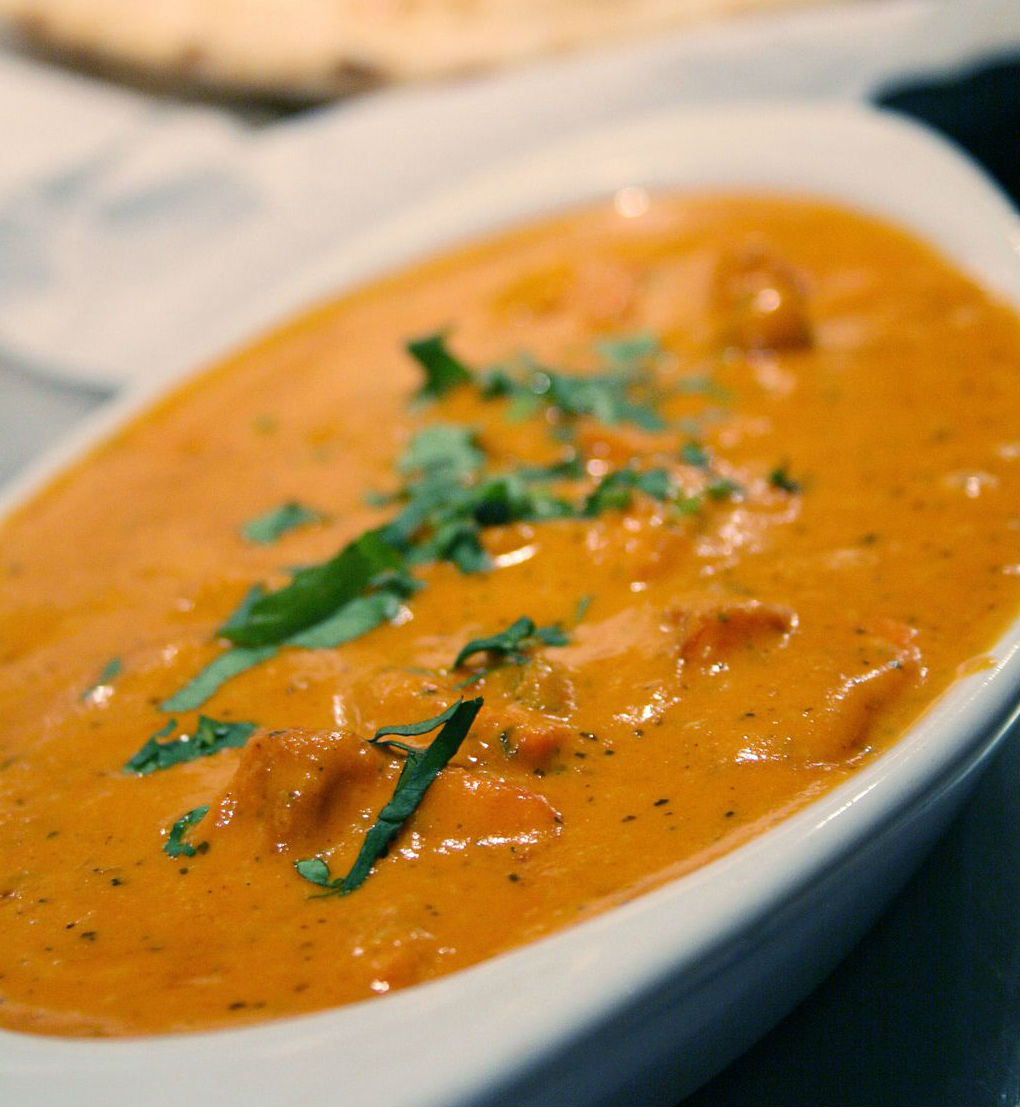
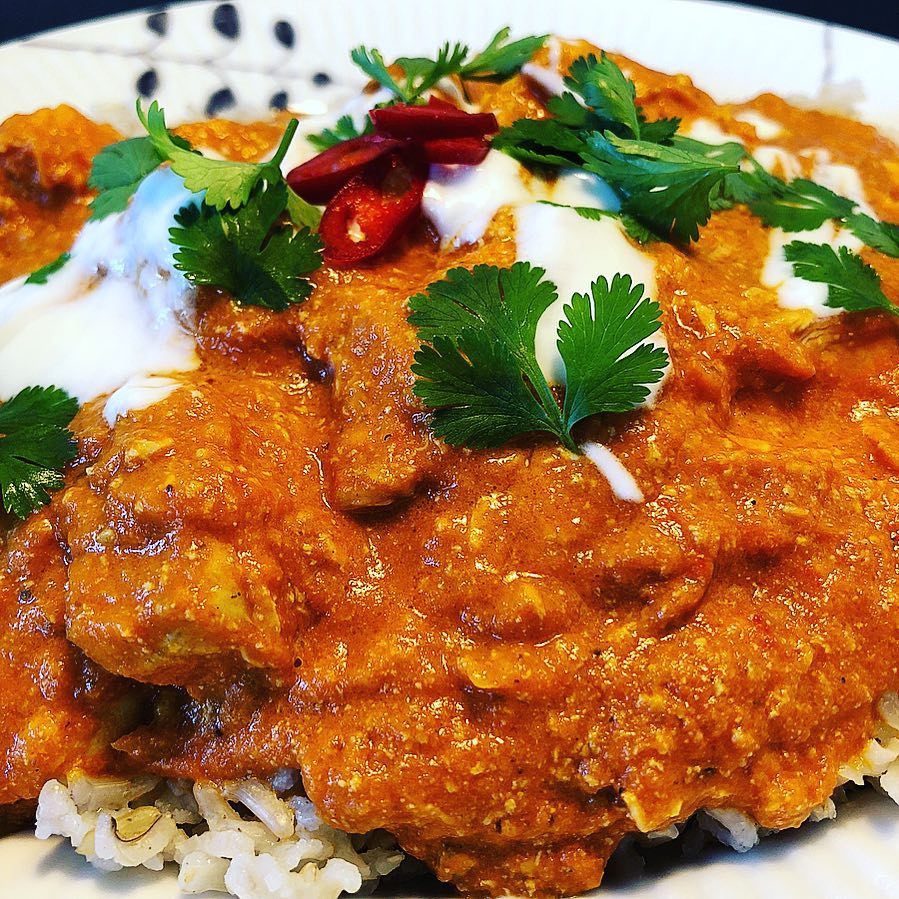
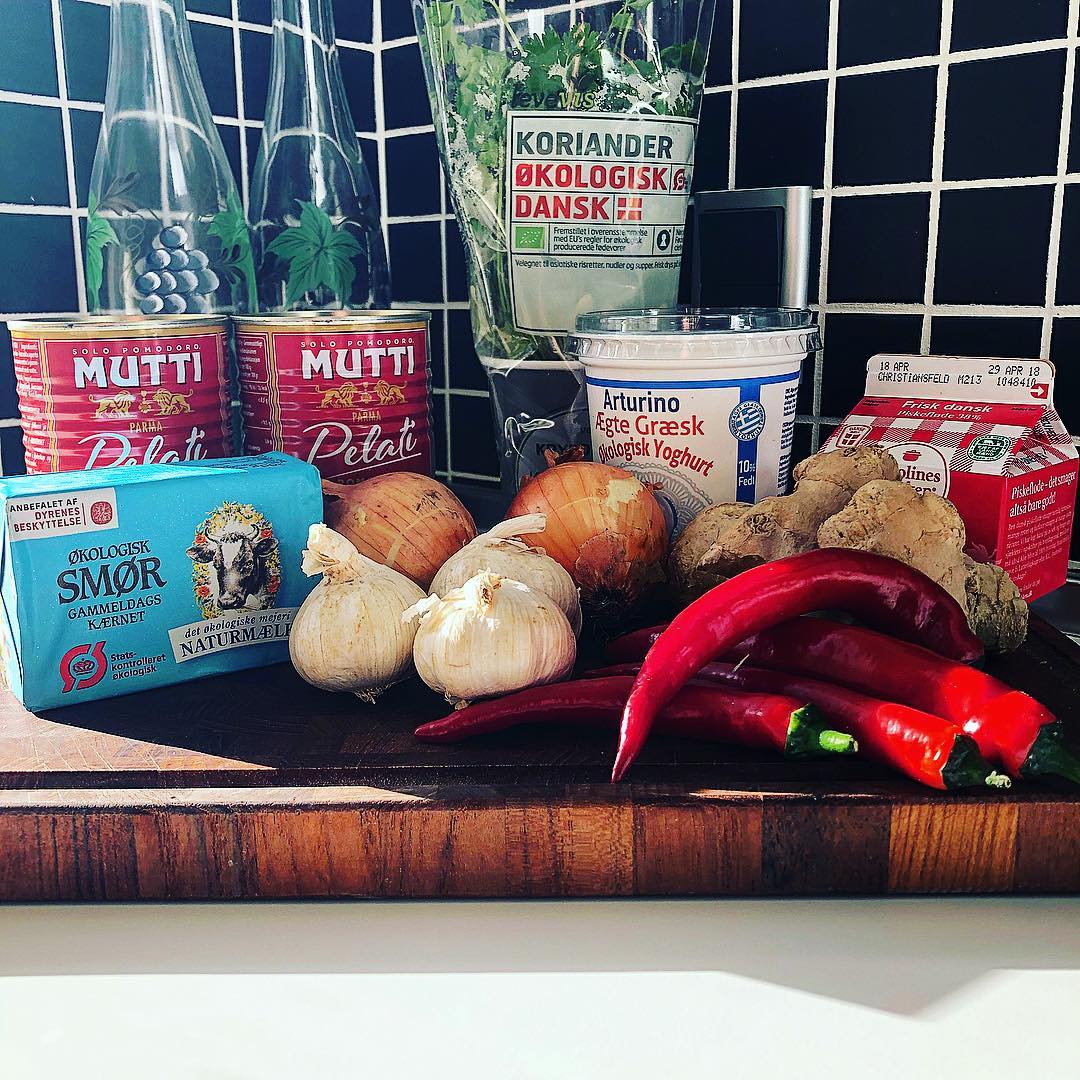
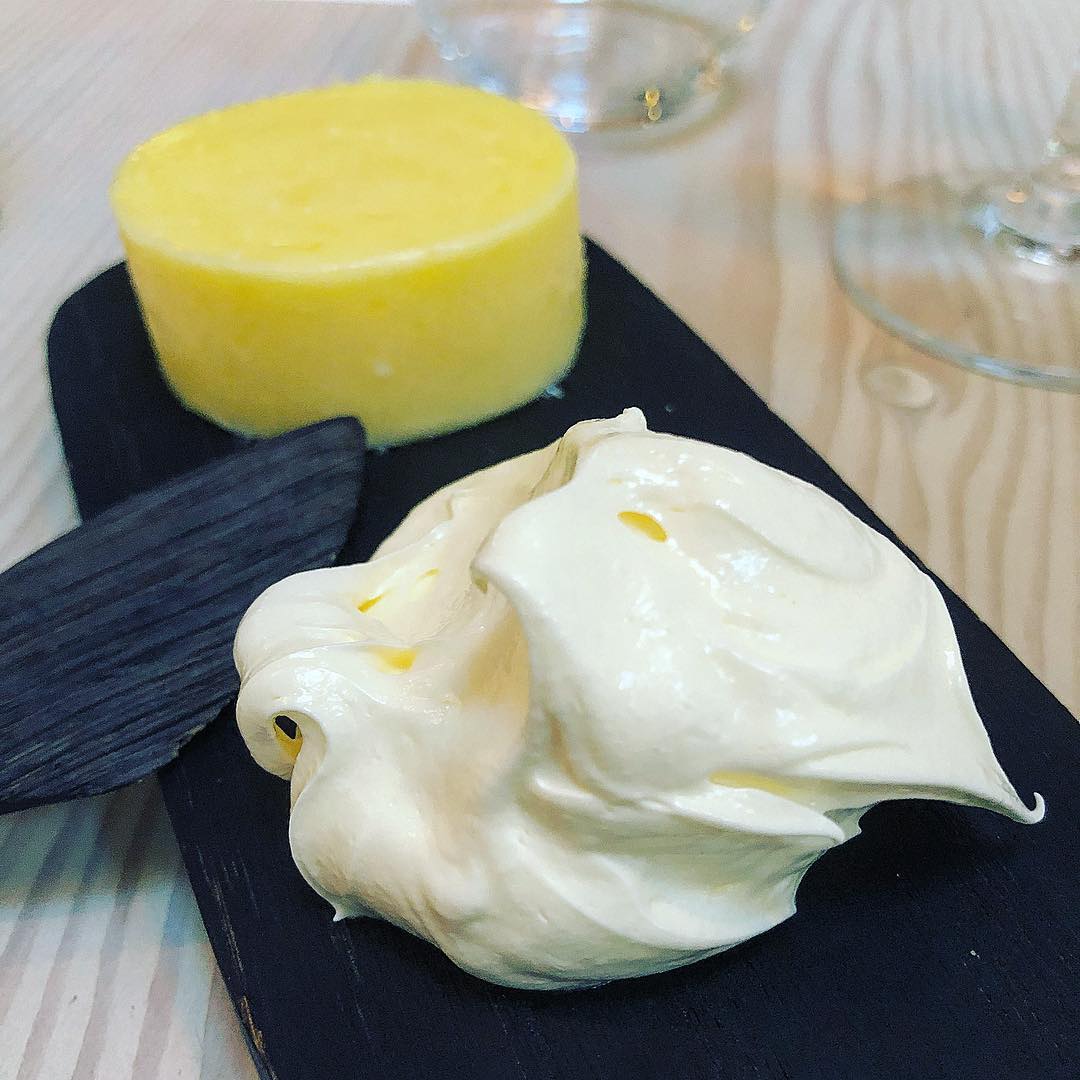

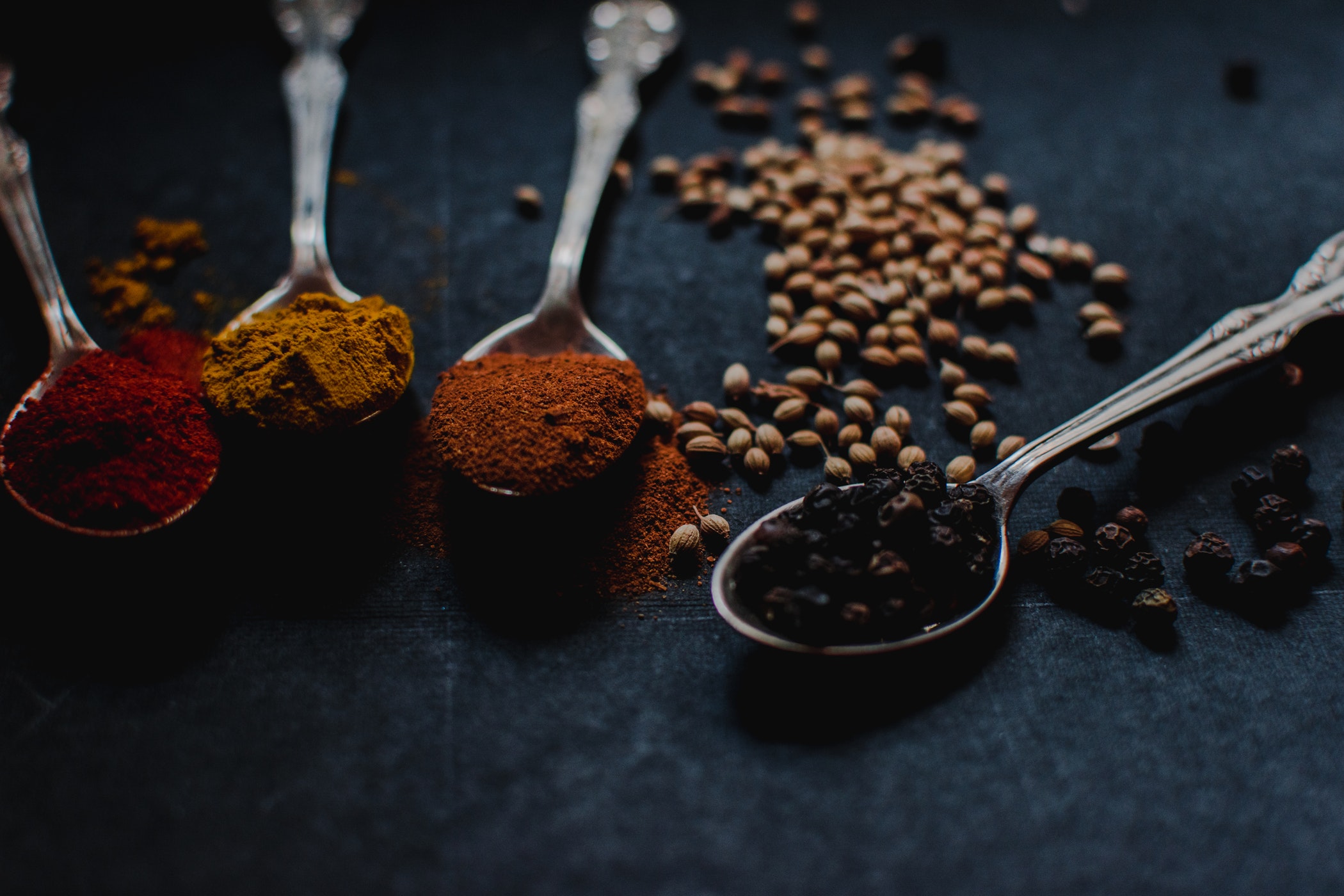
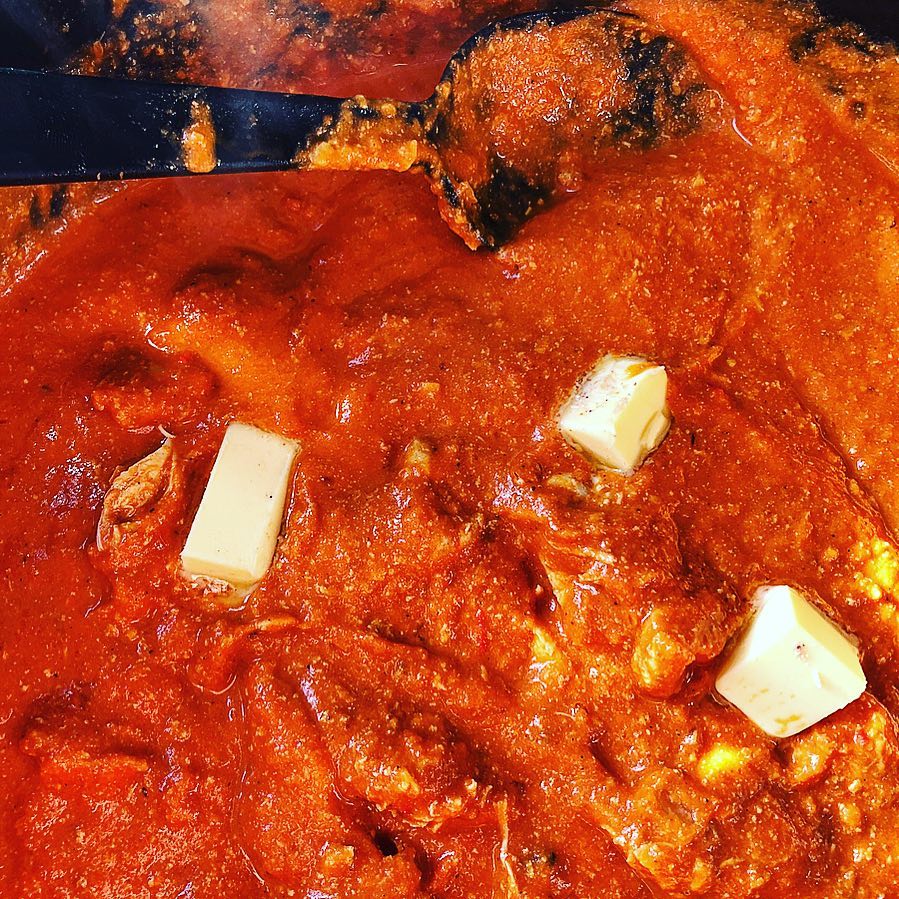
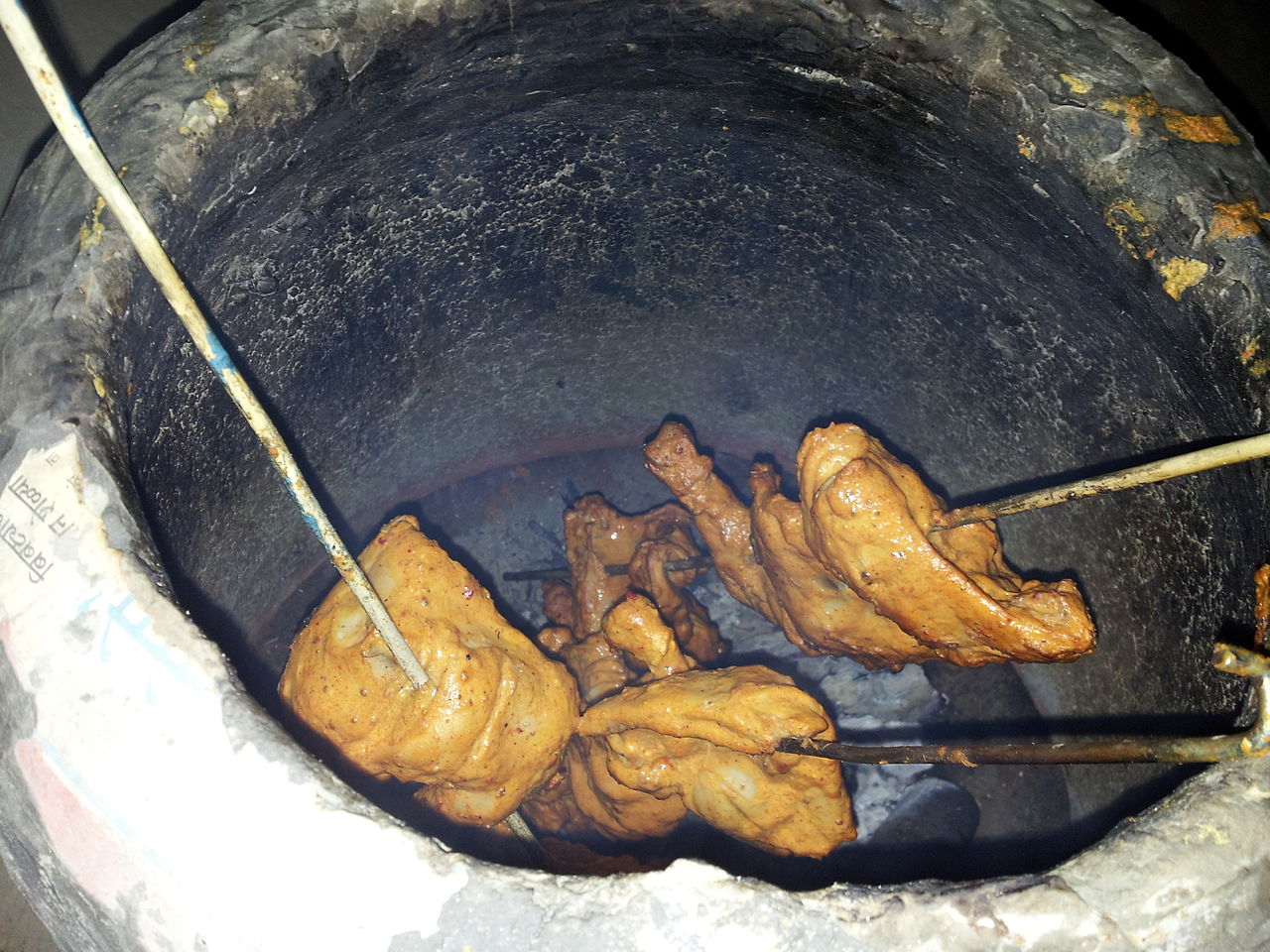
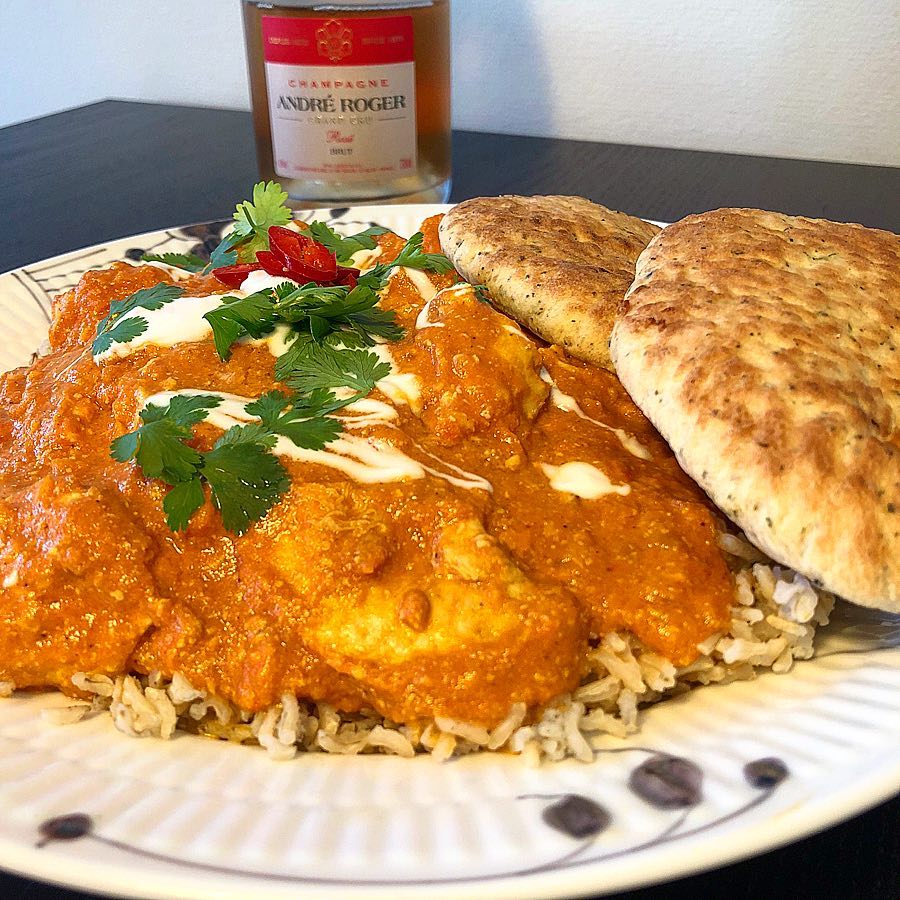
In the recipe, you say “ground chili” but in the photo earlier you have a fresh chili. Do you mean ground fresh chili?
Great question, Andrew. I meant dried, ground chili.The fresh chili in the picture I used primarily for decoration. I’m sorry about the confusion, thanks for pointing this out 🙂
What do u do with the remaining marinade,
You could probably refrigerate or freeze and reuse.
Hey Johan,
can I use garam masala bought in a store or do i have to make my own? 🙂
Hi Kathrine, you can of course use storebought if you so desire 🙂